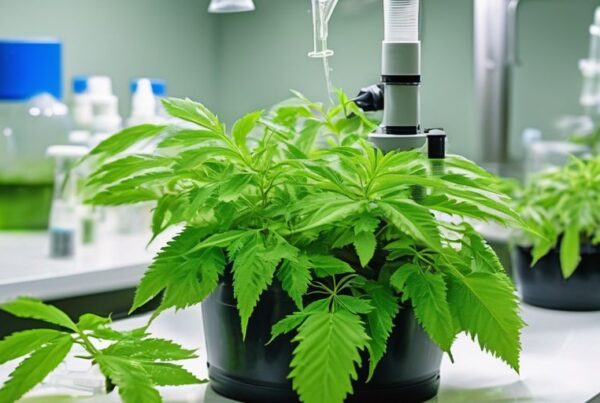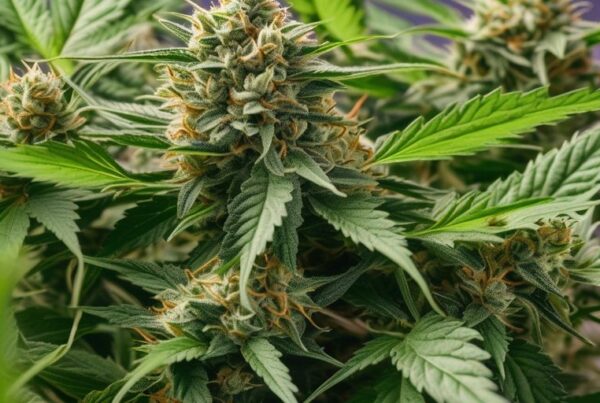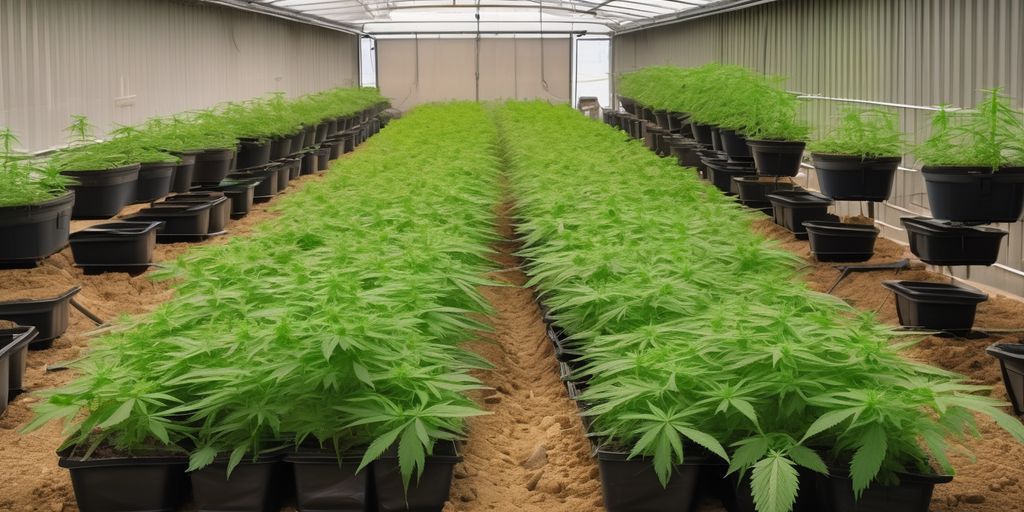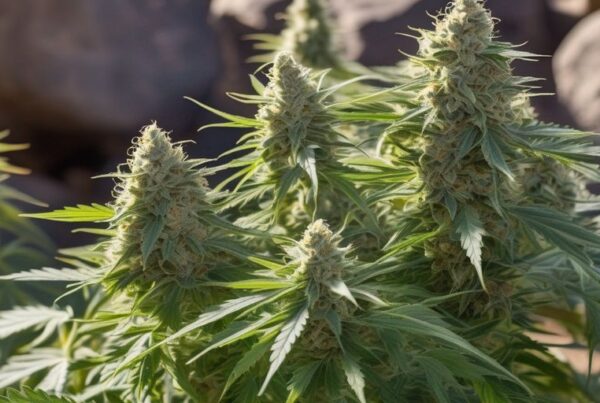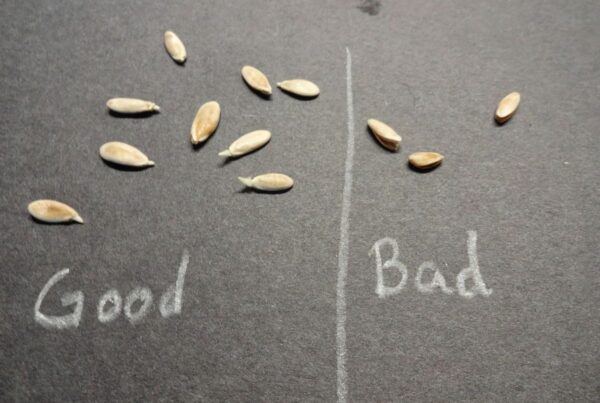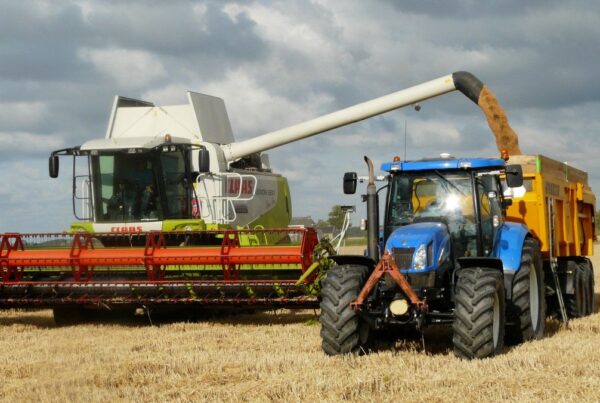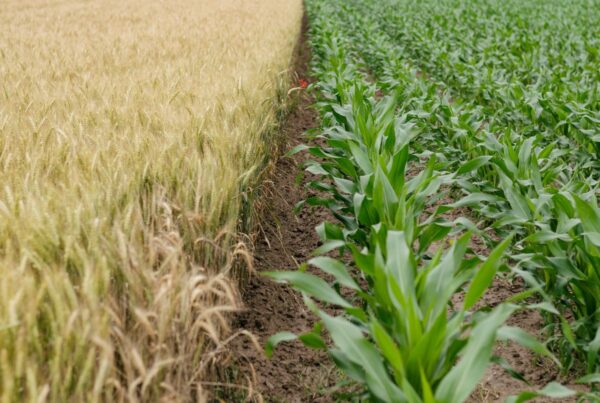In the cultivation of cannabis, the use of cover crops plays a pivotal role in maintaining and enhancing soil health. These crops, ranging from legumes to brassicas, not only enrich the soil but also support a sustainable ecosystem conducive to cannabis growth. This article explores the various benefits and strategies associated with integrating cover crops into cannabis cultivation.
Key Takeaways
- Cover crops like clovers, mustard, and cereal grains play a crucial role in living-soil systems by enhancing soil microbial activity and providing essential nutrients.
- These crops can be grown alongside cannabis or during the offseason to prevent erosion, suppress weeds, and manage pests.
- Legumes are particularly beneficial for fixing nitrogen in the soil, crucial for the nutrient-intensive cannabis plants.
- The strategic use of cover crops leads to reduced irrigation needs, lower use of synthetic nutrients, and overall cost savings in cannabis cultivation.
- Incorporating a diverse range of cover crops can lead to a healthier soil ecosystem, promoting better growth and yield of cannabis.
The Green Guardians: Choosing the Right Cover Crops
Legumes: The Nitrogen Ninjas
Down here in southern Oklahoma, we know a thing or two about the magic of legumes. These little nitrogen-fixing warriors are like the secret sauce to keeping our cannabis soil rich and ready. Think of them as your soil’s best friends—always there to lend a hand (or a root) by pulling nitrogen right out of the air and fixing it into the soil. It’s like having a mini fertilizer factory right under your feet!
Grasses and Grains: The Underground Architects
When it comes to building a strong foundation, grasses and grains are the go-to guys. They’re not just about looking pretty; they work hard to improve soil structure and prevent erosion. From rye to barley, each type has its own special way of enhancing the soil. And let’s not forget, a well-structured soil means a happy cannabis plant!
Brassicas and Broadleaves: Nature’s Biofumigants
Now, if you’re looking for the heavy hitters in the cover crop world, look no further than brassicas and broadleaves. These plants are like nature’s own pest control, releasing compounds that help suppress soil-borne diseases and pests. Plus, they’re great at breaking up compacted soil, making it easier for cannabis roots to spread out and thrive.
The Dirt on Soil Health: How Cover Crops Work
Erosion Control: Keeping It All Together
Ever watched a good ol’ Oklahoma thunderstorm and thought about all that rain beating down on your precious soil? Well, cover crops are like the unsung heroes here. They form a protective layer that reduces soil erosion by intercepting rainfall, improving water infiltration, and enhancing soil structure. It’s like having a security blanket over your soil, keeping it snug and intact.
Weed Suppression: Nature’s Own Weed Whacker
If you’re tired of playing whack-a-mole with weeds, cover crops are your new best friend. These green warriors compete with weeds for light, space, and nutrients, making it tough for those pesky plants to establish. It’s a natural and cost-effective way to keep your cannabis beds clean and clear, letting your main crop shine without the chemical warfare.
Microbial Magic: Boosting Soil Biodiversity
Cover crops aren’t just about keeping the soil together or fighting weeds; they’re also fantastic for the underground party. They feed a diversity of soil organisms, which in turn, support healthier soil and plants. Think of it as throwing a buffet for the microbes, where the menu changes with each cover crop you plant. This diversity is the spice of life that keeps your soil thriving and your cannabis happy.
Seasonal Strategies: Timing Your Cover Crop Cultivation
Offseason Opportunities: Rest and Replenish
When the ganja’s gone and the fields are bare, that’s your cue to get those cover crops in the ground. Think of it as a spa day for your soil—letting it rest and replenish with nutrients. It’s like hitting the reset button before the next growing season kicks in.
Growing Alongside Ganja: Companion Planting
Companion planting isn’t just for veggie gardens; it’s a game-changer for cannabis too. By planting the right cover crops alongside your cannabis, you can enhance soil health, deter pests, and even improve the overall yield. Remember, it’s all about choosing the right partners for your plants—some good buddies can make all the difference!
Transition Tactics: From Harvest to Health
Once you’ve harvested your cannabis, don’t let your soil go to waste. Planting cover crops right after harvesting can protect and enrich your soil, making sure it’s ready for the next round. It’s a smooth transition that keeps your soil working and your farm thriving.
Eco-Friendly Farming: Sustainability and Cover Crops
Water Wise: Reducing Irrigation Needs
Down here in southern Oklahoma, where the sun beats down like it’s got something to prove, every drop of water counts. That’s why we’re all about cover crops—they’re like having a secret weapon against drought. By improving soil structure and increasing infiltration, these green guardians help us cut down on the ol’ water bill. And let’s be honest, who isn’t looking to save a few bucks where they can?
Pesticide Reduction: Going Natural
Now, I don’t know about you, but I prefer my cannabis like I prefer my food—minus the chemicals. Cover crops are a game-changer here. They act like a natural bouncer, keeping those pesky weeds and insects at bay without needing to spray down the fields with stuff I can’t even pronounce. It’s all about keeping it clean and green, folks!
Cost Cutting: Economical and Environmental Gains
Let’s talk turkey—or should I say, let’s talk cover crops? These bad boys not only improve our farm’s health but also our wallet’s health. By reducing the need for inputs like water and pesticides, and even sometimes fertilizers, cover crops make a lot of sense economically. Plus, there are some sweet financial incentives out there for farmers looking to go the eco-friendly route. It’s a win-win, my friends!
Undercover Benefits: Hidden Perks of Cover Crops
Soil Structure and Fertility: Building from the Ground Up
Let’s talk dirt, folks! Improving your soil ain’t just about avoiding the mud on your boots. It’s about giving your plants a cozy bed to snuggle into. Cover crops are like the unsung heroes, working overtime to enhance soil structure and fertility. They’re the backbone of a healthy farm, ensuring your cannabis plants thrive even when the going gets tough.
- Boosts water infiltration: Say goodbye to puddles!
- Reduces soil compaction: More room for roots to groove.
- Enhances nutrient cycling: Nature’s own recycling program.
Attracting Allies: Creating a Bug Haven
Ever thought of bugs as your best buds? Well, in the world of cover cropping, they sure are! Planting a mix of cover crops like buckwheat and phacelia not only keeps the soil healthy but also turns your farm into a bug haven. These little critters are natural pest controllers, keeping the baddies away while promoting a balanced ecosystem.
Long-Term Land Love: Preserving Your Farm’s Future
Think of cover crops as your farm’s retirement plan. They’re not just about the here and now; they’re about ensuring your land stays productive and healthy for years to come. By preventing erosion and improving soil health, cover crops lay the groundwork for a sustainable future, making sure your farm remains a green oasis in southern Oklahoma.
The Science of Cover Crops: What Research Says
Studies on Soil Health
Research is pretty clear: cover crops are like a spa treatment for your soil. They boost organic matter, enhance soil structure, and increase biodiversity. Studies highlight the role of cover crops in improving soil health by promoting beneficial microbial activity and reducing erosion.
Impact on Cannabis Yields
Now, for the juicy part—how do these green guardians affect our beloved cannabis? Well, the verdict’s in, and it’s mostly thumbs up. Cover crops can lead to healthier soil, which often translates to more robust cannabis plants. Some studies even suggest that the right cover crop strategy can boost your yields, making it a win-win!
Future Trends in Cover Cropping
Looking ahead, the trend is leaning towards more innovative and sustainable farming practices. Cover cropping is no exception. Expect to see more research on specific crop combinations and advanced management techniques that could make even a seasoned farmer raise an eyebrow.
From Theory to Field: Practical Tips for Cannabis Growers
Alright folks, let’s get our hands dirty with some real talk about slinging cover crops into your cannabis game down here in southern Oklahoma. It ain’t just about throwing seeds in the ground and hoping for the best. Let’s break it down.
Choosing Your Crop Mix
First things first, picking the right cover crops is like choosing your fantasy football team. You gotta know who plays well with cannabis. Legumes are your MVPs for nitrogen fixing, while grasses keep your soil dressed better than a Sunday church service. Don’t forget the brassicas; they’re like the bouncers at the club, keeping pests and diseases in check.
Planting and Maintenance Best Practices
Now, planting ain’t just dig and drop. Timing is everything. Plant your cover crops right after you harvest your cannabis to give them a head start. Keep an eye on them like you would on a slow cooker. Too much water? Adjust. Weeds popping up? Get in there and show ’em who’s boss. It’s all about keeping that soil in prime condition for your next cannabis crop.
Monitoring and Adjusting for Optimal Growth
Last but not least, keep those eyes peeled. Monitor your crops like you’re binge-watching your favorite series. If something looks off, tweak it. Soil looking sad? Maybe it’s time for a nutrient boost. Cover crops not thriving? Could be time to switch up your strategy. Remember, every season is a chance to learn and improve.
Remember, integrating cover crops isn’t just a one-and-done deal. It’s a continuous cycle of learning, adapting, and perfecting your craft.
Wrapping It Up: The Green Guardians of Cannabis
So, there you have it! Cover crops are not just the unsung heroes of the cannabis world; they’re the backstage rockstars that keep the soil jamming long after the show is over. From clovers that pump up the nitrogen to rye that keeps the soil structure tight, these plants are like the ultimate roadies for your cannabis crops. They prevent erosion, enhance soil health, and even keep those pesky weeds at bay. So next time you’re planning your cannabis cultivation, remember to give a shoutout to these green guardians. After all, healthy soil means happy plants, and happy plants mean a bountiful harvest. Keep it green, keep it covered, and let’s make every pot a party for those roots!
Frequently Asked Questions
What are cover crops, and why are they important for cannabis cultivation?
Cover crops, such as clover, mustard, and cereal grains, are planted to enhance soil health by preventing erosion, suppressing weeds, and fostering a healthy soil food web. They are vital in cannabis cultivation for maintaining soil integrity, improving soil structure, and promoting biodiversity, which leads to healthier cannabis plants.
Which cover crops are best for cannabis farms?
The best cover crops for cannabis farms include legumes like clovers and alfalfa for nitrogen fixation, grasses and grains such as cereal rye, oats, and wheat for adding organic matter, and brassicas like mustard for biofumigant properties. Broadleaf crops like buckwheat are also recommended for mulching and soil benefits.
How do cover crops benefit the soil and cannabis plants?
Cover crops enhance soil structure, prevent erosion, suppress weeds, and promote biodiversity. They help in nutrient cycling, improve water retention, and foster the growth of beneficial microbes, creating a healthier environment for cannabis plants to thrive.
Can cover crops be used during the cannabis growing season?
Yes, cover crops can be grown alongside cannabis plants or during the offseason. When grown with cannabis, they help in fending off harmful pests and during the offseason, they protect the soil from erosion and help maintain its fertility.
What are the economic benefits of using cover crops in cannabis cultivation?
Using cover crops can reduce the need for irrigation, pesticides, and soil replacements, lowering overall costs. They also contribute to sustainable organic agriculture by improving soil health and reducing environmental impact.
How do cover crops contribute to sustainable agriculture?
Cover crops are a key component of sustainable agriculture. They protect soil health, reduce dependency on chemical inputs, and enhance biodiversity, which is crucial for maintaining long-term soil fertility and a healthy agricultural ecosystem.
Related Articles
